Sukhmathi, showed us her tattoos, the smile never fading from her lips. She was a member of the mysterious Baiga tribals of Madhya Pradesh. We were in the heart of India, Madhya Pradesh. As part of the tribal trail curated by Times Passion Trails of Times Group in association with Madhya Pradesh Tourism, we were in the remote village of Silpidi in the Dindori Tehsil of Dindori District of Madhya Pradesh, India. Sukhmathi, like other women of her Baiga tribe, had their bodies ornamented with tattoos, a distinctive feature of the Baigas.
Table of Contents
Rendezvous With The Mysterious Baiga Tribe
It was with much anticipation, that we reached the remote village of Silpidi. We were enjoying our tryst with the tribals of Madhya Pradesh on the Times Passion Tribal Trail. This was another close interaction with tribals after our amazing experience with the Galos of Arunachal Pradesh some years back.
The whole village of Silpidi seemed to have turned up to welcome us. Tribal men dressed in traditional attire in flamboyant yellow and black hues and the women dressed in a pleasing pink, with colourful headgear, literally kicked up the dust with a pulsating dance and music performance. We were given a ceremonial welcome and were treated to some lilting tribal songs.
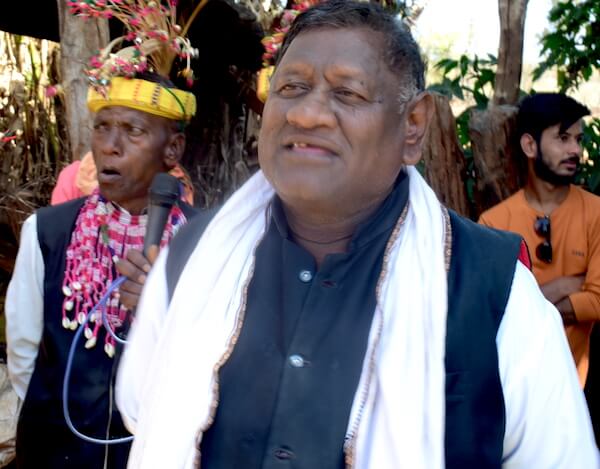
The entire performance was coordinated by none other than Shri Arjun Singh Dhurve, who is one of those on the list of Padma Shri awardees for the year 2022. Shri Arjun Singh Dhurve is the first Post Graduate Degree Holder from the Baiga tribe, and his achievements include the popularization of Baiga dance and music. It was our privilege to learn more about the Baiga tribe and culture during our interaction with Shri Arjun Singhji and the villagers of Silpidi.
Baiga Tribe In India Map
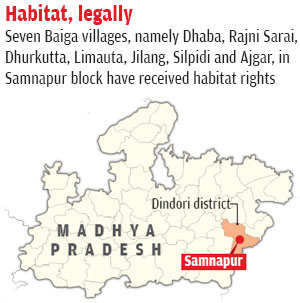
Who Are The Mysterious Baiga Tribe Of Madhya Pradesh
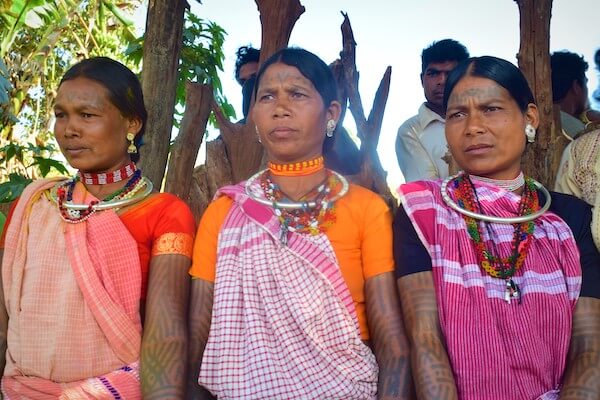
The mysterious Baiga Tribe of Madhya Pradesh, find first documented reference in a British army report of 1867. The report that was prepared by Captain W.B.Thomson refers to the Baiga tribe as, “the wildest of the tribes, inhabiting the most inaccessible hills and the remotest forests; living on what they can secure with their bows and arrows, in the use of which they are very skilful, and on forest produce, and the small crops which they grow on the hillside.”
A later entry dating to 1912 in the Mandla Gazetteer describes the Baigas thus: “They are the most primitive and interesting of the forest tribes, but they have completely lost their language if they ever had one, their origin is obscure, but they are almost certainly older established than the Gonds.”
The Baigas are actually believed to have originated as a sub-branch of the Bhumia tribe of Chhota Nagpur. The Baigas were essentially forest dwellers, living deep in the jungles in harmony with nature. However, over the years deforestation and the march of development has ensured that they migrate to places nearer the cities. Today the Baiga tribe is concentrated in the state of Madhya Pradesh, but can also be found inhabiting parts of Uttar Pradesh, Chhatisgarh, and Jharkhand also.
The mysterious Baiga tribe may have lost a bit of their intrigue owing to adapting to contemporary lifestyles, but they still retain part of their original indigenous culture and way of life. With the march of time, new attires may have come, but they still retain their traditional attire; time has brought new gods and deities but they still worship their traditional deities. Development has forged new forms of adornment, but the traditional adornment of tattoos still survives.
Famous Baiga Tribe Tattoo
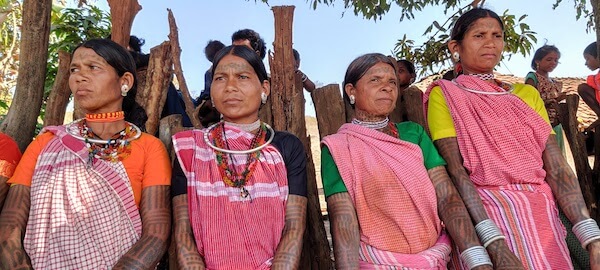
The Baiga women at Silpidi were the centre of attraction with their colourful and vibrant attire. However, the tattoos that ornamented their bodies were the cynosure of all eyes. Many of the women had tattoos from head to toe. The tattoos consisted of geometrical designs or motifs of nature. What was the objective of the tattoos? Were they purely for cosmetic reasons or had a deeper significance?
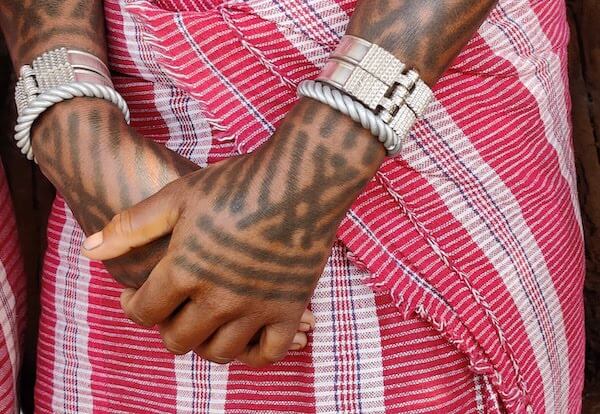
We gathered more information about this esoteric art of tattooing and the science behind it through our discussions with the locals, as well as Shri Arjun Singh Dhurve; Shri Vasanth Nirguneji, the experienced architect for the Tribal Trail; Dr Vijay Chourasiaji, an expert on the tribals of Madhya Pradesh; The Baigas, a book by anthropologist, Verrier Elwin.
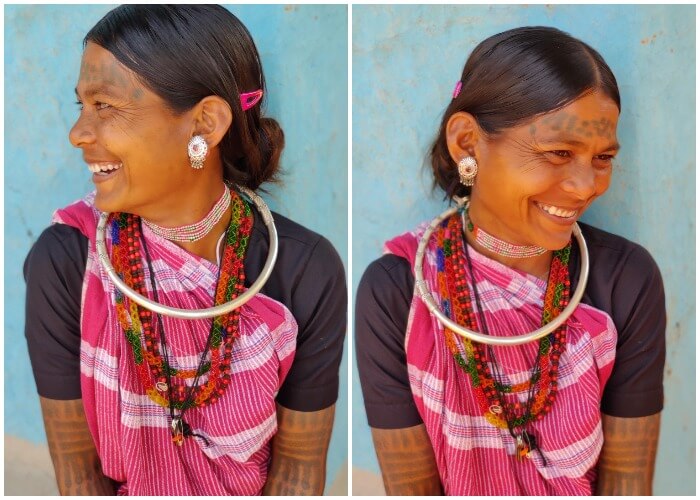
Dr Vijay Chourasia who is a practising Doctor who is working towards the preservation of tribal culture and heritage and also authored 8 books, enlightened us about the Baiga tattoos.
“Tattooing is called godana and these are done for the Baigas by the Badis who are a sub-tribe of the Gonds,” said Dr Vijay Chaurasia, as he went on to elaborate more on the subject. What is interesting to note is that tattoos are done on the entire body. First girls are tattooed on the forehead just before attaining puberty, and tattoos over the entire body are done at different stages in their lives.
Dr Chaurasia goes on to explain the philosophical beliefs behind the custom of tattooing among the Baiga tribe, thus: “The Baigas believe that when we wore born, we came naked and naked we shall die, the Godan or tattoos are our adornments, and this is what we shall take with us when we die and go to God. If we don’t go to God with these tattoos, God will punish us.”
It is a point to ponder here regarding the men who with some exceptions, do not have these kinds of tattoos.
Elwin Verrier in his book on the Baigas writes, “Men are seldom tattooed, but they sometimes put the Chandrama (moon), on the back of the hand and the hichhn (scorpion)on the forearm, they sometimes tattoo themselves on the affected parts in order to cure rheumatism.”
Elwin Verrier describes the typical tattoo marks on a traditional Baiga woman thus, “The usual marks tattooed on a Baiga woman are these: a triangular decoration is made on the forehead when a Baiga girl is about five years old. On the breast is a peacock, or a datiri (basket) and on the arm the haldi-gdth (the turmeric root). These are done when the girl reaches puberty.
At the time of marriage or later, a jliophari (a pattern of any kind) may be made on the back of the hand, the lines of dots known as paldni or kajeri on the thighs, and in between the paldni the bail ankhi. On the knee is the phulwy round like a flower, and on the back arc flies, men, the sakri or magic chain, and the dhandha . On the legs are fish-bones and the chakmak (steel).”
The winds of change are sweeping over the Baiga tribe too and tattooing is now on the decline. With education and exposure to urban lifestyles, the younger generations are not that keen to go in for full body tattooing like their earlier generations.
The Baiga Tribal House
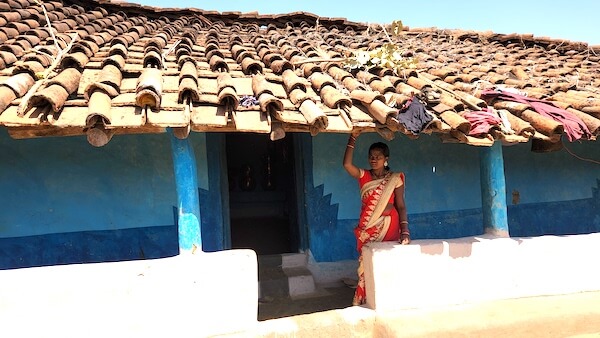
Traditionally the Baigas lived in the forests and were nomadic in nature. Their traditional houses reflect these aspects. We were introduced to the Baiga traditional home at the Bhopal Tribal Museum by Shri Vasant Nirguneji.
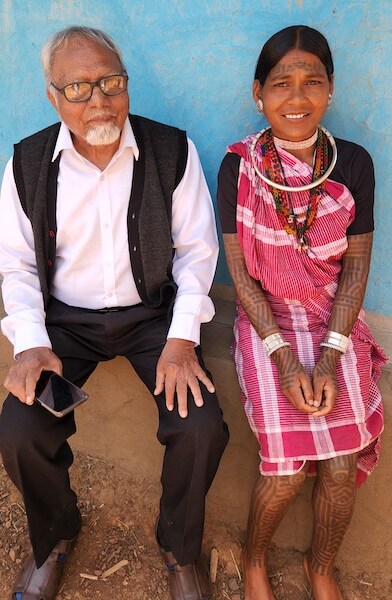
Traditionally Baiga houses were built around a central shared courtyard where a bonfire blazed during the nights. This was apparently to scare away wild animals. The model Baiga House at the Tribal museum consisted of a room with a sloped roof. Traditionally the roof was made with grass and tree leaves, however currently these have been replaced by clay. A notable feature of the houses is that there are many items of utility hanging from the roof for easy accessibility.
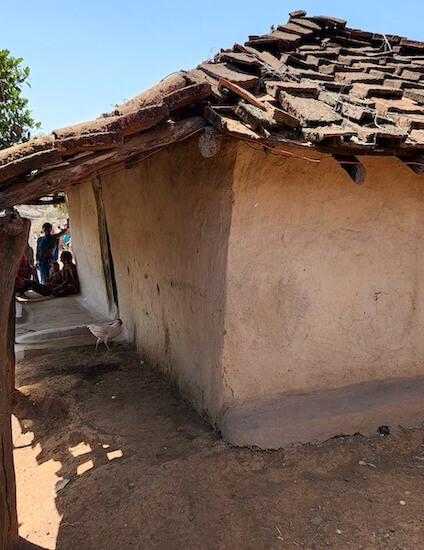
Verrier Elwin notes in his book; “The Baiga house is very small but it is often cosy enough and always scrupulously clean. Most of the household goods are hung from the roof oily and black from the smoke of constant fires.”
The house and the courtyard are both encircled by fencing consisting of tree trunks to protect the house from predatory animals. However, the homes have evolved as the tribe has moved nearer cities and the materials used in the construction of their houses too have changed. In the Baiga homes of Silpidi, this was evident, though vestiges of the traditional way still existed in different aspects of their homes.
Baiga Tribe Food
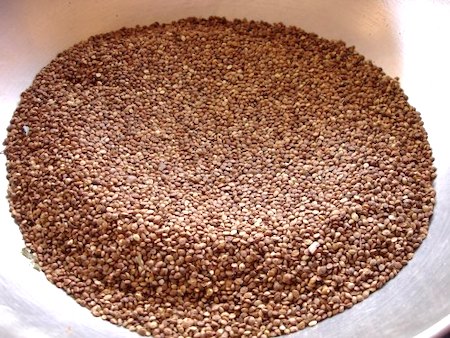
The Baigas believe that the earth is their mother and they do not want to plough it again and again. They practice a form of shifting cultivation called, “Bewar.” Some Baigas have however taken to normal ploughing nowadays. Traditionally the Baigas have depended on the forests and its vegetation for food and livelihood. They have an instinctive and vast knowledge of the bounty of the forest.
Their food consists of Sikiya millet that grows on its own in Bewar patches of land. Sikiya is used to make rice and roti called ghas ki roti, by the Baigas. The Baigas also eat different kinds of mushrooms and other wild foods including leafy green vegetables and fruits.
Though over time, because of changed circumstances, the Baigas have taken to tilling the land, the Bewar crops of the millets known as Kodo and Kutki continue to be the staple diet of the Baigas. Pej is another important item in the diet of the Baigas. It is a concoction of crushed corn, wheat, Kodo, Kutki, water is added to this and this liquid is relished by the tribe and is considered to be very healthy.

Mahua is another important aspect of Baiga’s food and drink. It is an intoxicant prepared from the fermentation and distillation of the flowers of the Mahua tree ( Madhuca longifolia). The Baigas drink this spirit which assumes more importance, especially during festivals and other celebrations.
Baiga Tribe Clothing | Baiga Tribe Dress
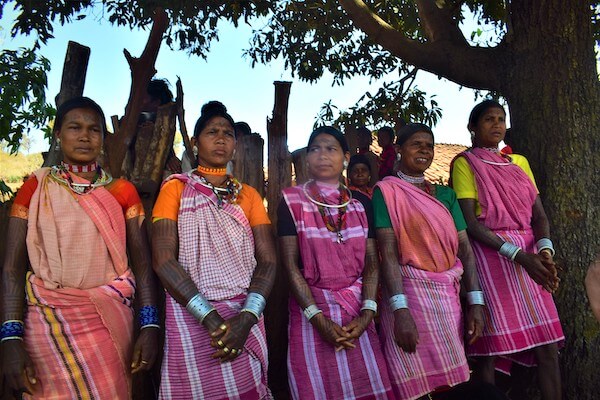
The Baigas traditional wear has changed over the years, but Verrier Alvin gives us a glimpse of what the traditional dress of the Baigas was like, many years ago. According to him, the orthodox Baiga tradition was to wear as little as possible. The men wore short dhotis, sometimes as short as a Langot (Loin cloth), and also cover their head with a piece of cloth.
In fact, many Baigas believe that wearing too much cloth results in poverty. According to Baiga tribal legend, Nanga Baiga, who was the first Baiga man to be created, was given a piece of cloth that measured 9 Hands long. Nanga Baiga kept only the cloth measuring about one and half hands long and returned the remaining cloth as not needed. The propensity of the Baigas to wear minimal clothing can be traced to this ancient legend of Nanga Baiga.
The Baiga women traditionally wear a dress that is known as Lugra or Chitra. It consists usually of a pink coloured cloth that is tied around the waist. The cloth is then carried across the breasts over the right shoulder and then tucked at the back.
The Lugra, thus forms a skirt that reaches just above the knee. The women also like to wear colourful accessories that include necklaces, bracelets, armlets, and bangles. These are usually made of colourful beads, coins, as well as silver and aluminium. Apart from this the most important component of the Baiga woman’s ensemble is the tattoos that adorn her body.
Baiga Tribe Festivals And Deities
The Baiga Tribe traditionally has had a symbiotic relationship with the forest. The forest and its wealth are treated like a mother by the Baigas. The forest has provided them with their daily necessities and they respect the forest and its trees and wildlife for this. The Baigas pray and take the permission of the forest Goddess or Van Devi before they use its produce. Hence it is natural that many of their deities and festivals are connected with nature.
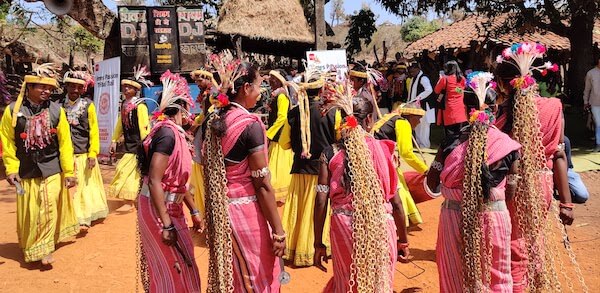
One of the unique festivals celebrated by the Baiga tribe is the Ras Nava festival which occurs every 9 years and coincides with the blooming of a plant called Mohti. This festival is related to the process of Honey extraction. Only after the celebration of this festival, the tribe extracts honey in that particular year. Dasara Naach is another interesting festival that is celebrated as an ode to the bounty of nature.
The tribe reinforces its commitment to the protection of nature. The festival that takes place in the night is marked by singing and dancing by the youth. The festival also fosters friendship and courtship amidst the young boys and girls who may decide to marry if things work out.
There are other festivals too that coincide with Holi, Dasara, and Diwali, that is celebrated by the Baigas, though they are unique and different. Some of the more interesting festivals and ceremonies celebrated by the Baigas include the Phag festival in which the women beat the men!
The Baiga tribe worship a plethora of deities and the list has evolved over time. The chief deity of the Baigas is Bhagawan, the entity that is responsible for the creation and who is forever benevolent. Another important deity is Bada Dev. Some other deities include Dharthi Ma or Mother Earth; Bhimsen, the God of rain; Gansam Dev, the deity who protects against the attacks of wild animals.
The Baigas were the priests with knowledge about magic and sorcery. The Dewar of the Baiga tribe is the person who is regarded with reverence and the one who officiates in various rites and ceremonies. This status of the Baigas ensures that they are consulted on various matters pertaining to agriculture, health, and other issues by different tribes including the Gonds.
Dance And Music Of The Mysterious Baiga Tribes
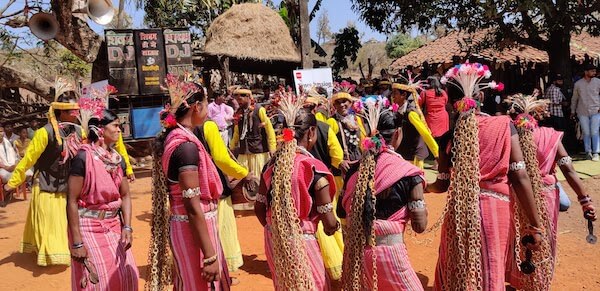
As we found out in our brief encounter with the Baiga community, dance and music is an inherent and integral part of their culture. Music and dance seem to come naturally to them. Probably listening to the eternal music of nature and seeing the dance of the trees ruffled by the wind, instils in them a natural proclivity towards dance and music.
The Baiga dance whenever the season or their loves invite;give them a bright moon and a little liquor, and their feet begin to move unbidden, and their hands stray towards the drums. – Verrier Elwin
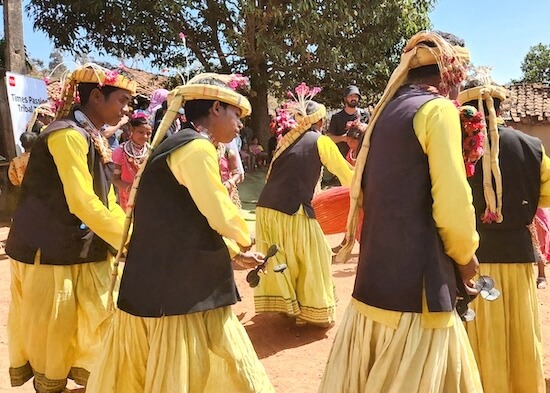
Every life event ranging from religious festivals and ceremonies, births, weddings, and deaths is an occasion to indulge in music and dance. The Baigas also use drums, flutes, and other instruments to accompany their dancing and singing. The dance forms of the Baigas include Tapadi, Reena, Saila or Dassera, and Karma, among others.
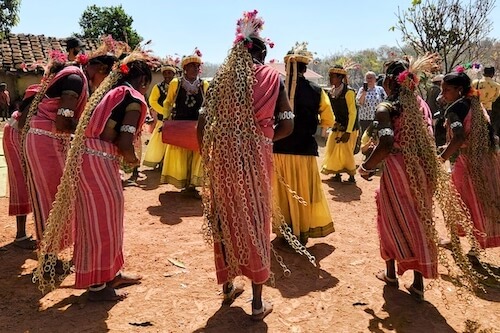
The Baigas take their dances seriously and dress painstakingly for them. While the men wear ornaments and a turban bedecked with peacock feathers, the women adorn themselves with different ornaments and tie their hair in pigtails with little rings made from tree bark and wool. They use wooden clappers called Tiski and different types of drums.
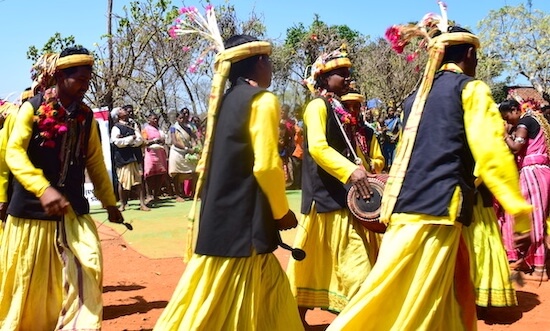
The Karma dance is the mother of all dances of the Baiga tribe. Other dances are but variations of the Karma dance. This is a dance in which the young and the old, men and women participate with great enthusiasm. The dance consists of a group of musicians and singers in the centre. Around these are two formations, one consisting of the men and the other of the women.
The Story Of Creation – The Legend Of The Baiga Tribe
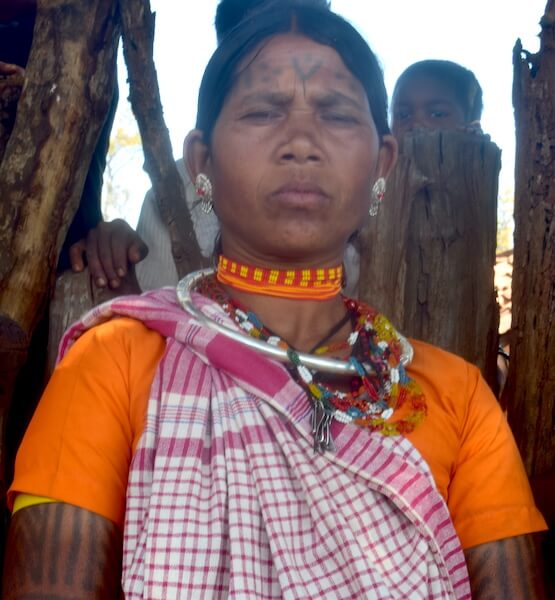
The culture of the Baiga tribals is rich with legends and myths that have been bequeathed across generations in an oral tradition. One of the most fascinating of these legends is that of the genesis or creation of the Baigas. The Baigas have many legends related to the creation of mankind and the most interesting and popular of these is this one.
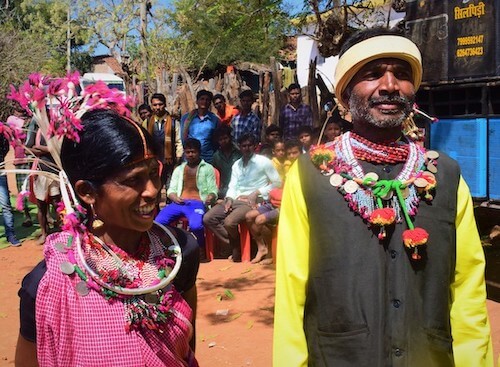
This is the legend of Nanga Baiga and Nanga Baigin which echoes with the creation of Adam and Eve in western mythology. It is also interesting to note the connection with Hindu mythology. Verrier Elwin describes this legend in his book:
“Baba Vashishta Muni was sitting in deep meditation on the Kajli-ban-pahar ( Hill of Elephants), when two drops of his urine, one a full drop and the other a half drop fell to the ground. From these were born Nanga Baiga and Nanga Baigin.”
There are many myths about how Nanga Baiga and Nanga Baigin, the First Man and the First Woman came on the earth. However, it is the general legend that they lived in the forest eating roots, and one fine day they were lured by their intrinsic nature and yielded to temptation. In course of time, the primordial couple had two sons and two daughters who married each other, and thus the Baiga race was born. Legend also has it that one branch was that of the Baigas and the other of the Gonds.
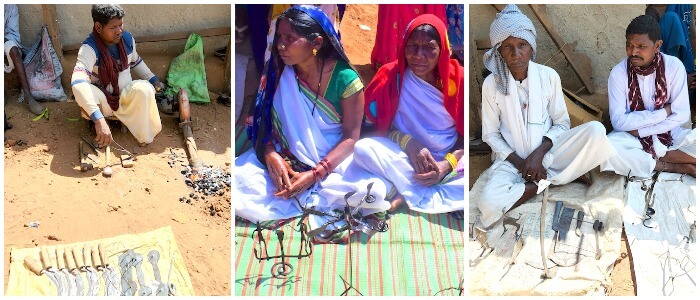
It is interesting to note that many of the legends of the Baiga Tribe also feature other tribes like the Gond and the Agariyas. In one of the legends associated with creation, God after having created the earth, realized that it was not steady and was shaky. So he created the Agariyas who created 4 large nails. After this Nanga Baiga Nanga Baiga firmly nailed the four corners of the earth. We met a few members of the Agariya community at Silpidi. They are traditionally iron smelters and wear white. In terms of social class, the Baigas consider themselves superior to the Agarias and would not eat in their houses.
Baiga Tribe Images
We present here a few Baiga Tribe images.

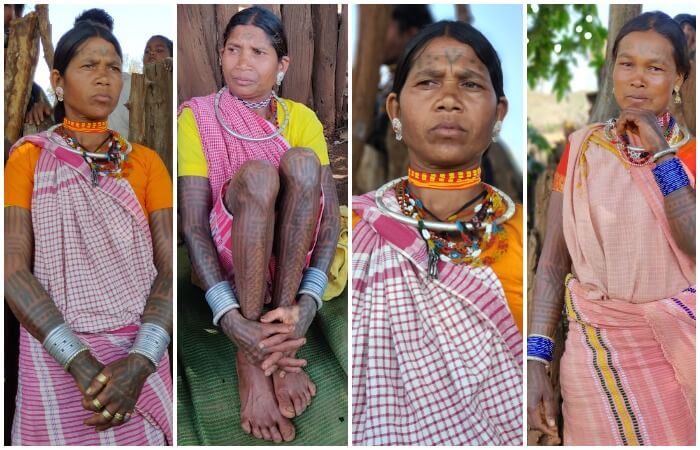
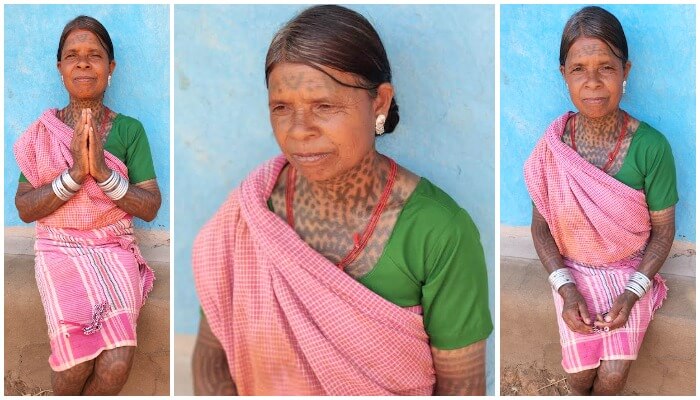
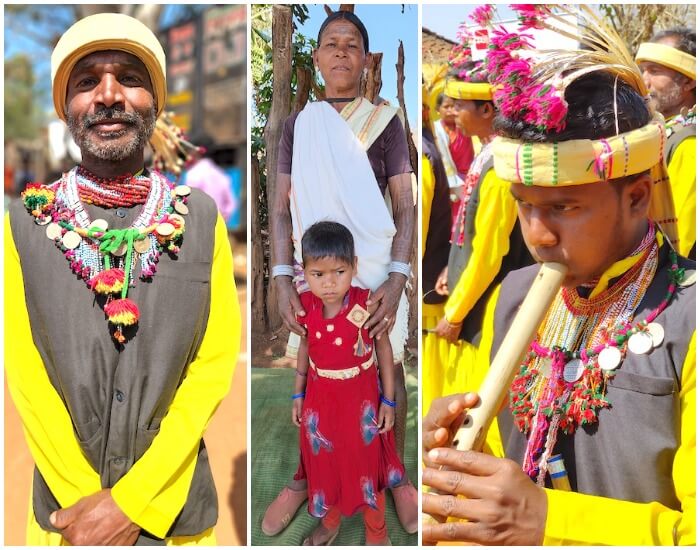
The Baigas today stand poised on the threshold of development, and the challenge to them and society at large is to ensure their economic development while at the same time the sustenance of their rich culture and heritage. This is a very brief peep into the lives and the culture of the Baigas and a minuscule effort as compared to many who have given their lives to the study of this tribe. We hope you find our post about the mysterious Baiga tribe interesting and stokes your own curiosity to know more.
Do write to us about your thoughts through our comments section and subscribe to our blog for more interesting content. Do follow us on our social media handles to stay updated with our travels and travel stories.
This was part of a tribal trail curated and organized by Times Passion Trails ( Times of India ) and Madhya Pradesh Tourism under the #DekhoApnaDesh and #AzadiKaAmritMahotsav initiative. The views and opinions expressed in this blog post are our own. #timespassiontrails #tribaltrail #TimesofIndia #MPTourism #HeartOfIndia #MadhyaPradesh
Below are some useful resources to help you book flights, hotels, and tours! And also clothes, luggage and accessories for your trip!
Flights – TripAdvisor or CheapAir or Cleartrip or Makemytrip or Priceline
Tours – Click here to book top tours around the world
Hotels – Click to book the best hotels/resorts
Choose best stay options with TripAdvisor or Cleartrip or ixigo or Makemytrip or goibibo or Hotelscombined or Priceline
Apparels – Click to buy Menswear or Womenswear or Kidswear
Accessories/Luggage – Click to buy Accessories and Luggage items
Beauty Products – Click to buy Personal Care and Beauty Products
Do You Love Traveling?
Do you want to know how to travel the world? We have put together a very useful travel resources page with the best travel tips. Go check it out now.
Thanks for visiting our site Voyager – imvoyager.com and taking the time to read this post!
If you wish to collaborate/work with us then reach us at [email protected]
We’d love it if you’d comment by sharing your thoughts on this post and share this post on social media and with your friends.
Follow our journey on our social media channels:
Facebook Twitter Instagram Pinterest YouTube
60+ Million Users Trust TripAdvisor With Their Travel Plans. Shouldn’t You?
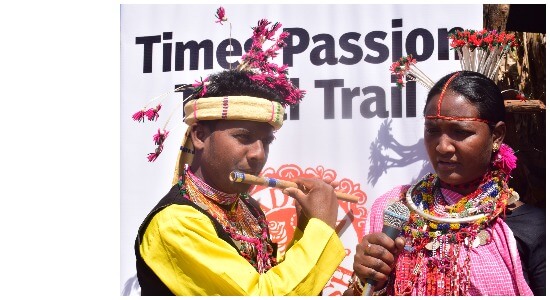
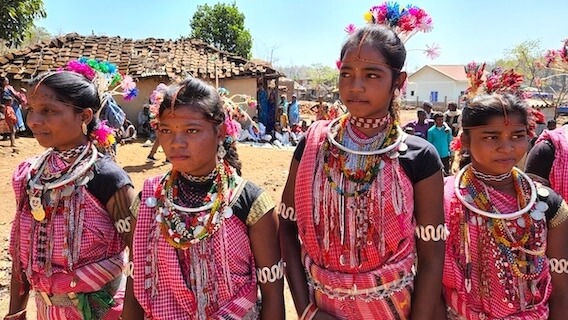
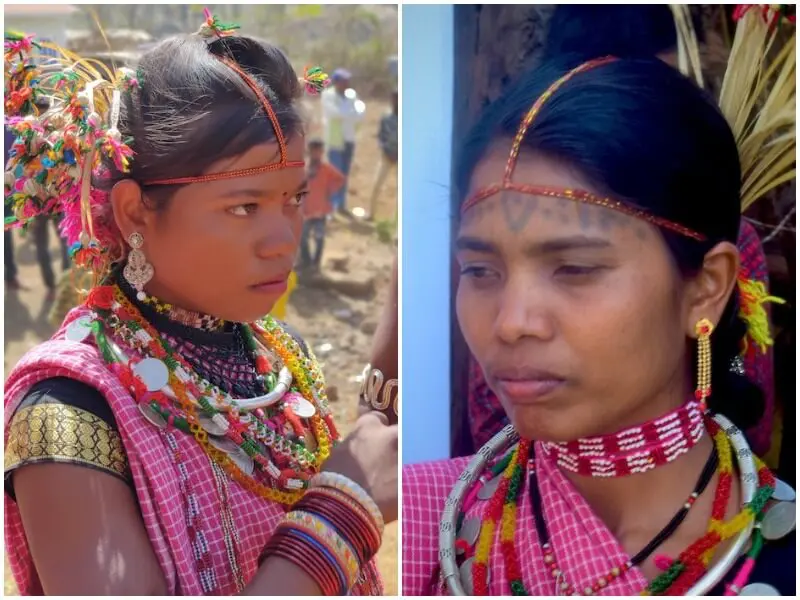
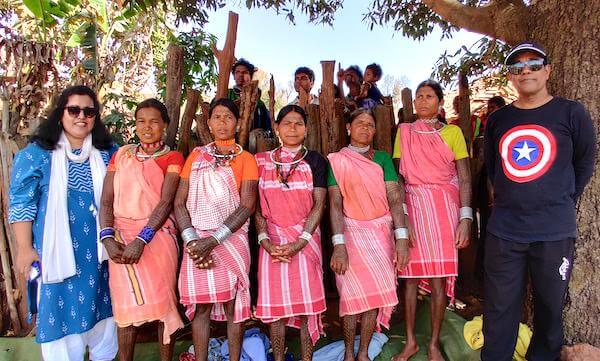
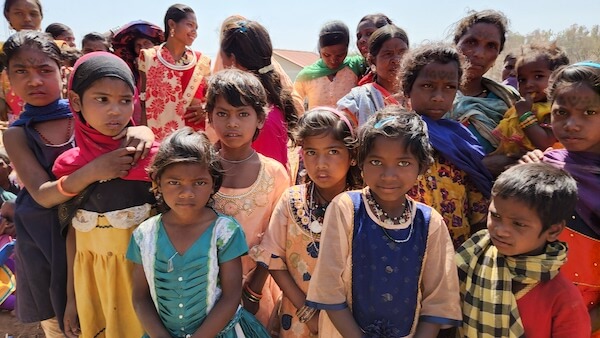
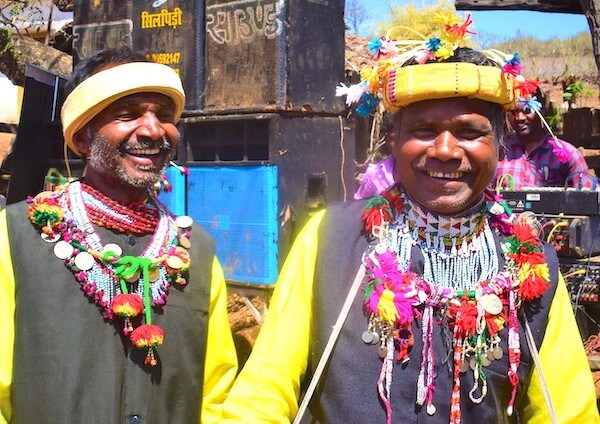
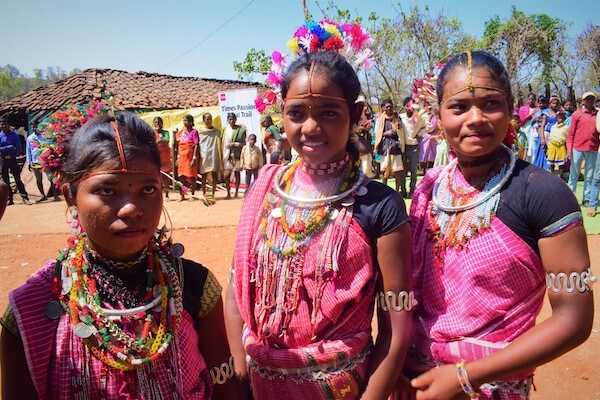
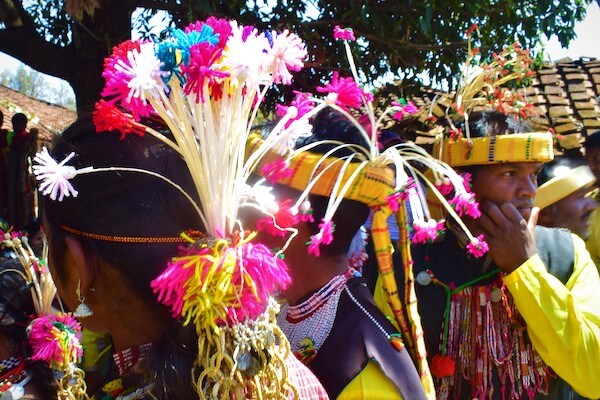
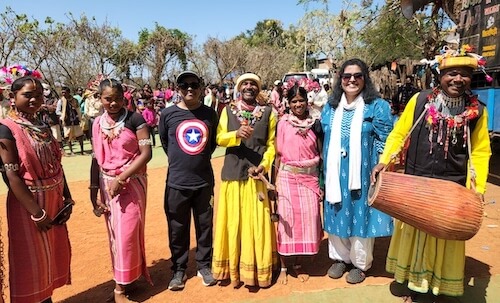
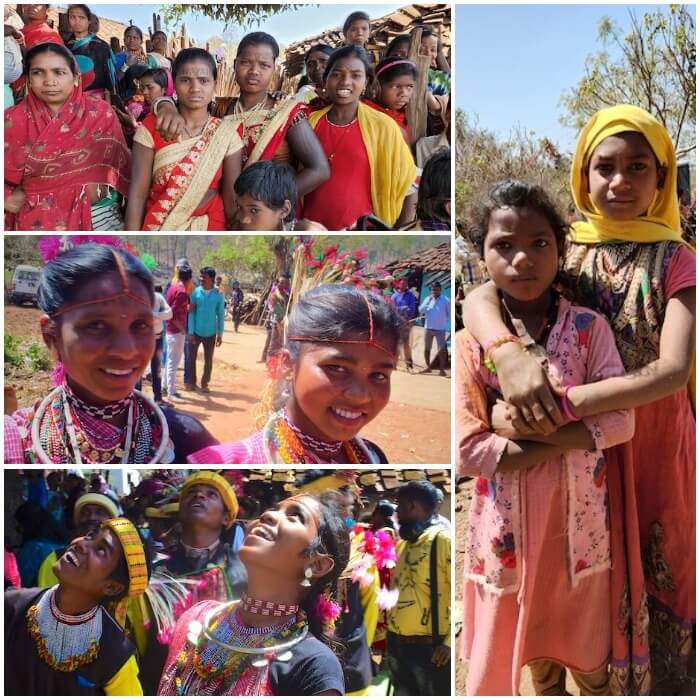
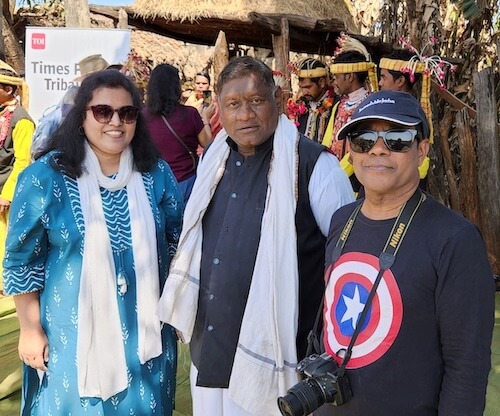

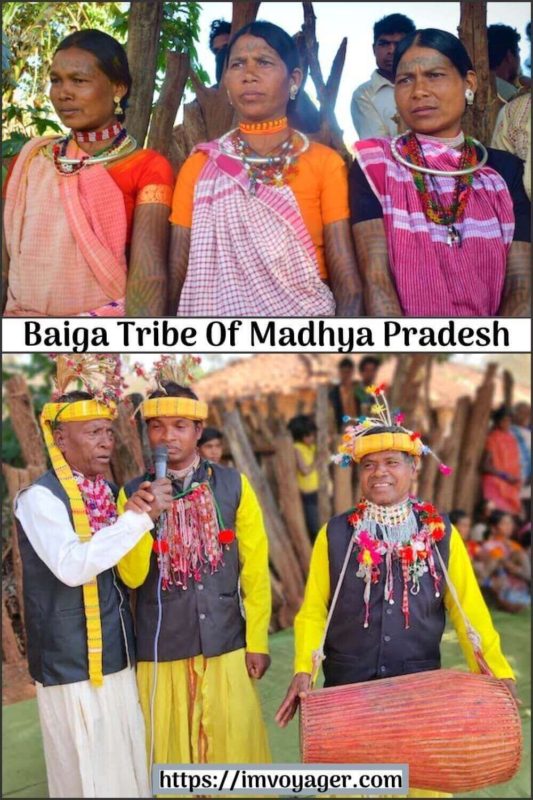


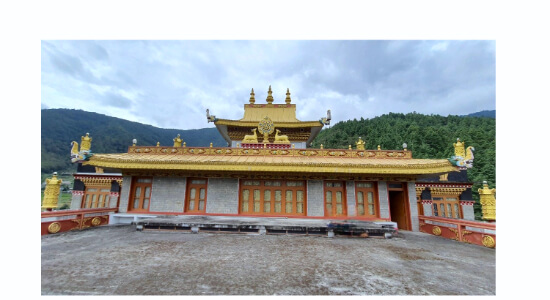

Fascinating. I always enjoy learning about other cultures. This tribe seems interesting!
I love learning about other cultures. Thanks for sharing all the photos of their traditional wear and dances!
Wow this was such an interesting read. I didn’t know much about them. I love learning about new cultures. And this is so close home. Thanks for sharing this one.
What an interesting tribe to learn about. I love the tattoos on the women. I also thought it was neat they they originally living in harmony with nature. I wish life could be more like that.
This was my first time learning about the Baiga Tribe, thanks for sharing this very informative post.
It is really amazing to learn about cultures. I enjoy reading this, this is so informative.
I had never heard about the Baiga Tribe before. I did find the tattooing of the women very interesting. That it started when a girl hit puberty and again when they get married. Thank you for a very interesting article on the Biga Tribe of Madhya.
The village looks very welcoming and I’m so much interested in their tattoos. Thanks for sharing this
It’s so beautiful to discover new people and cultures. Baiga tribe is like a journey in the past.
I’ve never heard of this tribe before. It sounds like they are an interesting people. It’s interesting to hear about the different deities they worship and also about their myths.
I found your post totally fascinating. I loved learning about this tribe, one I have never heard of and wished I had. How beautiful are their colors.
This is the first time I’ve heard about this tribe, they look so welcoming people! Thanks for sharing this with us
I have heard about this Baiga tribe but haven’t got the opportunity to meet them in person! Thanks for sharing about Baiga tribe, their myths, culture and your experience with us 🙂 Loved reading this post.
This is so interesting, and to imagine that this tribe lives right in the center. fascinating read and i liked how you covered so many aspects of their lives. i can see how beautifully they are integrating with the modern people and world while continuing with their traditions.
I had a great time reading your article. The history of the mysterious Baiga tribe piqued my interest. I was also fascinated by the fact that they live in harmony with nature. In real life, I wish things were more like that. It irritates me that men do not have tattoos like women do; God only punishes women after they die.
It was lovely reading about your tryst with the tribals of Madhya Pradesh on the Times Passion Tribal Trail. I am intrigued to know more about these tribals. Maybe I will go on this trail someday.
One of the fascinating journey for sure. Loved the way you described each and every tribes and their colours. I really want to visit MP again to explore more such community.
I had heard about the Baiga tribe and might have read something in passing about the symbolism in tatoos. However they are a rather closed community perhaps . What you have written is like a fairy tale from the mysterious Madhya Pradesh. Drooling over the photograph and the costumes of the tribe. More power to you.
Such a detailed description of Baiga tribes. It was such an interesting experience reading about them, their culture and even the significance of tattoos. Just somedays back we were talking about a trip to MP next October. And here’s your post. Thanks dear.
This is the first time I am hearing about this tribe. So nice to know about them. There is so much to know about our country’s own people.
Very insightful post. Learned so much today. Baiga tribe teaches us so many life lessons like respecting nature ,Minimalist approach, adapting with time and many more. Adorning tattoo through out their body sounds really fascinating.
I love meeting and exploring the culture of local tribes. Honestly speaking I had never heard of Baiga Tribe before but their culture and legends seem fascinating. Would love to visit MP and learn and meet them.
There are so many native tribes in our country. This article really helped me to know more about the Baiga tribe, I wasn’t aware of this tribe and it was great knowing about their culture.
It was great reading such a detailed post about Baiga tribes since I hadn’t heard about them before this. I love their tattoos. Meeting them must’ve been a one-of-a-lind experience, isn’t it?
Indian history is so diverse and full of joy and happiness. Thank you for bringing about this beautiful tribe with us. Love to us traditional Indian people and cultures.
This is perhaps the first time I’m reading about the Baiga Tribe of Madhya Pradesh. Tribal art and culture never ceases to amaze me; I hope more people can read this post to know about this tribe!
I don’t know somehow when I hop here I learn something new. So glad you have shared the tribe and their food and all so nicely.
Wow very informative article